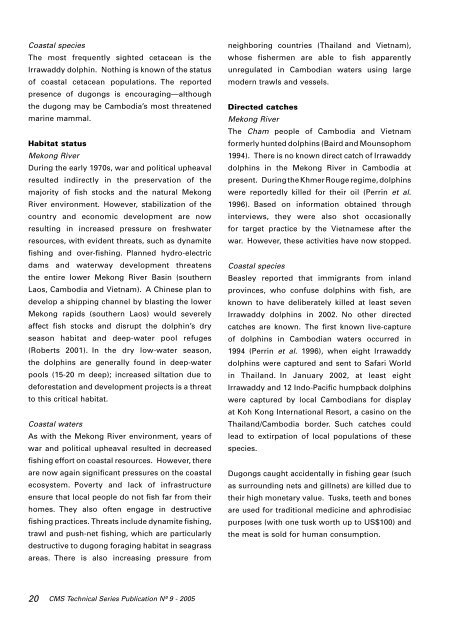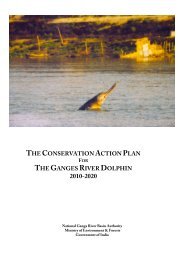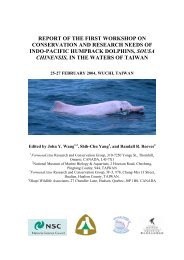Report of the Second Workshop on The Biology and Conservation of ...
Report of the Second Workshop on The Biology and Conservation of ...
Report of the Second Workshop on The Biology and Conservation of ...
You also want an ePaper? Increase the reach of your titles
YUMPU automatically turns print PDFs into web optimized ePapers that Google loves.
Coastal species<strong>The</strong> most frequently sighted cetacean is <str<strong>on</strong>g>the</str<strong>on</strong>g>Irrawaddy dolphin. Nothing is known <str<strong>on</strong>g>of</str<strong>on</strong>g> <str<strong>on</strong>g>the</str<strong>on</strong>g> status<str<strong>on</strong>g>of</str<strong>on</strong>g> coastal cetacean populati<strong>on</strong>s. <strong>The</strong> reportedpresence <str<strong>on</strong>g>of</str<strong>on</strong>g> dug<strong>on</strong>gs is encouraging—although<str<strong>on</strong>g>the</str<strong>on</strong>g> dug<strong>on</strong>g may be Cambodia’s most threatenedmarine mammal.Habitat statusMek<strong>on</strong>g RiverDuring <str<strong>on</strong>g>the</str<strong>on</strong>g> early 1970s, war <strong>and</strong> political upheavalresulted indirectly in <str<strong>on</strong>g>the</str<strong>on</strong>g> preservati<strong>on</strong> <str<strong>on</strong>g>of</str<strong>on</strong>g> <str<strong>on</strong>g>the</str<strong>on</strong>g>majority <str<strong>on</strong>g>of</str<strong>on</strong>g> fish stocks <strong>and</strong> <str<strong>on</strong>g>the</str<strong>on</strong>g> natural Mek<strong>on</strong>gRiver envir<strong>on</strong>ment. However, stabilizati<strong>on</strong> <str<strong>on</strong>g>of</str<strong>on</strong>g> <str<strong>on</strong>g>the</str<strong>on</strong>g>country <strong>and</strong> ec<strong>on</strong>omic development are nowresulting in increased pressure <strong>on</strong> freshwaterresources, with evident threats, such as dynamitefishing <strong>and</strong> over-fishing. Planned hydro-electricdams <strong>and</strong> waterway development threatens<str<strong>on</strong>g>the</str<strong>on</strong>g> entire lower Mek<strong>on</strong>g River Basin (sou<str<strong>on</strong>g>the</str<strong>on</strong>g>rnLaos, Cambodia <strong>and</strong> Vietnam). A Chinese plan todevelop a shipping channel by blasting <str<strong>on</strong>g>the</str<strong>on</strong>g> lowerMek<strong>on</strong>g rapids (sou<str<strong>on</strong>g>the</str<strong>on</strong>g>rn Laos) would severelyaffect fish stocks <strong>and</strong> disrupt <str<strong>on</strong>g>the</str<strong>on</strong>g> dolphin’s dryseas<strong>on</strong> habitat <strong>and</strong> deep-water pool refuges(Roberts 2001). In <str<strong>on</strong>g>the</str<strong>on</strong>g> dry low-water seas<strong>on</strong>,<str<strong>on</strong>g>the</str<strong>on</strong>g> dolphins are generally found in deep-waterpools (15-20 m deep); increased siltati<strong>on</strong> due todeforestati<strong>on</strong> <strong>and</strong> development projects is a threatto this critical habitat.Coastal watersAs with <str<strong>on</strong>g>the</str<strong>on</strong>g> Mek<strong>on</strong>g River envir<strong>on</strong>ment, years <str<strong>on</strong>g>of</str<strong>on</strong>g>war <strong>and</strong> political upheaval resulted in decreasedfishing effort <strong>on</strong> coastal resources. However, <str<strong>on</strong>g>the</str<strong>on</strong>g>reare now again significant pressures <strong>on</strong> <str<strong>on</strong>g>the</str<strong>on</strong>g> coastalecosystem. Poverty <strong>and</strong> lack <str<strong>on</strong>g>of</str<strong>on</strong>g> infrastructureensure that local people do not fish far from <str<strong>on</strong>g>the</str<strong>on</strong>g>irhomes. <strong>The</strong>y also <str<strong>on</strong>g>of</str<strong>on</strong>g>ten engage in destructivefishing practices. Threats include dynamite fishing,trawl <strong>and</strong> push-net fishing, which are particularlydestructive to dug<strong>on</strong>g foraging habitat in seagrassareas. <strong>The</strong>re is also increasing pressure fromneighboring countries (Thail<strong>and</strong> <strong>and</strong> Vietnam),whose fishermen are able to fish apparentlyunregulated in Cambodian waters using largemodern trawls <strong>and</strong> vessels.Directed catchesMek<strong>on</strong>g River<strong>The</strong> Cham people <str<strong>on</strong>g>of</str<strong>on</strong>g> Cambodia <strong>and</strong> Vietnamformerly hunted dolphins (Baird <strong>and</strong> Mounsophom1994). <strong>The</strong>re is no known direct catch <str<strong>on</strong>g>of</str<strong>on</strong>g> Irrawaddydolphins in <str<strong>on</strong>g>the</str<strong>on</strong>g> Mek<strong>on</strong>g River in Cambodia atpresent. During <str<strong>on</strong>g>the</str<strong>on</strong>g> Khmer Rouge regime, dolphinswere reportedly killed for <str<strong>on</strong>g>the</str<strong>on</strong>g>ir oil (Perrin et al.1996). Based <strong>on</strong> informati<strong>on</strong> obtained throughinterviews, <str<strong>on</strong>g>the</str<strong>on</strong>g>y were also shot occasi<strong>on</strong>allyfor target practice by <str<strong>on</strong>g>the</str<strong>on</strong>g> Vietnamese after <str<strong>on</strong>g>the</str<strong>on</strong>g>war. However, <str<strong>on</strong>g>the</str<strong>on</strong>g>se activities have now stopped.Coastal speciesBeasley reported that immigrants from inl<strong>and</strong>provinces, who c<strong>on</strong>fuse dolphins with fish, areknown to have deliberately killed at least sevenIrrawaddy dolphins in 2002. No o<str<strong>on</strong>g>the</str<strong>on</strong>g>r directedcatches are known. <strong>The</strong> first known live-capture<str<strong>on</strong>g>of</str<strong>on</strong>g> dolphins in Cambodian waters occurred in1994 (Perrin et al. 1996), when eight Irrawaddydolphins were captured <strong>and</strong> sent to Safari Worldin Thail<strong>and</strong>. In January 2002, at least eightIrrawaddy <strong>and</strong> 12 Indo-Pacific humpback dolphinswere captured by local Cambodians for displayat Koh K<strong>on</strong>g Internati<strong>on</strong>al Resort, a casino <strong>on</strong> <str<strong>on</strong>g>the</str<strong>on</strong>g>Thail<strong>and</strong>/Cambodia border. Such catches couldlead to extirpati<strong>on</strong> <str<strong>on</strong>g>of</str<strong>on</strong>g> local populati<strong>on</strong>s <str<strong>on</strong>g>of</str<strong>on</strong>g> <str<strong>on</strong>g>the</str<strong>on</strong>g>sespecies.Dug<strong>on</strong>gs caught accidentally in fishing gear (suchas surrounding nets <strong>and</strong> gillnets) are killed due to<str<strong>on</strong>g>the</str<strong>on</strong>g>ir high m<strong>on</strong>etary value. Tusks, teeth <strong>and</strong> b<strong>on</strong>esare used for traditi<strong>on</strong>al medicine <strong>and</strong> aphrodisiacpurposes (with <strong>on</strong>e tusk worth up to US$100) <strong>and</strong><str<strong>on</strong>g>the</str<strong>on</strong>g> meat is sold for human c<strong>on</strong>sumpti<strong>on</strong>.20 CMS Technical Series Publicati<strong>on</strong> Nº 9 - 2005





